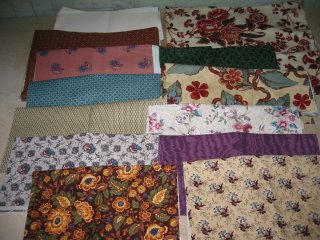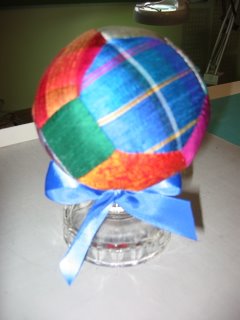I spent this week working on one of these - a Civil War sampler that began as a $5 quilt top. You probably know how that works - pay $5 for the first kit of fabric and pattern, then as long as you bring back the finished block each month you get the next month's kit for free. I had one last block that needed doing. I'd kept up nicely - but then the shop closed on Memorial day almost 2 years ago. We got our last block kit, but no sashing or border patterns or fabric. The instructor arranged for us to meet elsewhere, but charged $5 a month for the pattern and furnished no fabric. I was able to get the sashing patterns but not the border patterns. I finished the last block on Sunday night, and put them up on the wall.
Keeping in mind what Sharon Craig talks about in "Setting Solutions" and "Great Sets" - I highly recommend these books - I picked a pieced sashing and added a bunch of new colors. I chose from Civil War reproduction fabrics I've collected, but kept to brighter and more colorful choices. I finished setting the blocks together today. I wish I could remember what the borders on her two samples looked like. I know they were pieced, but that's all I remember. So I've hung this up on my design wall, hoping it will tell me what I need to do for borders. I want more than just strips of fabric. On March 23rd, I attended my second Pre-1830's medallion class. I received my second "packet", which included the rest of the fabrics for my center, my second handout, a vintage postcard, and a letter from my "dear sister". If you remember, the first month I had a letter from my "loving husband" along with some chintz and muslin he'd sent me for "the quilt I spoke of making for our bed". This time the included fabric was sent by my "sister" - scraps from making clothing for various family members. She was one of the people my husband visited on his trip, and he told her I was making a quilt for our bed. Here is a picture of my first two sets of fabrics.
On March 23rd, I attended my second Pre-1830's medallion class. I received my second "packet", which included the rest of the fabrics for my center, my second handout, a vintage postcard, and a letter from my "dear sister". If you remember, the first month I had a letter from my "loving husband" along with some chintz and muslin he'd sent me for "the quilt I spoke of making for our bed". This time the included fabric was sent by my "sister" - scraps from making clothing for various family members. She was one of the people my husband visited on his trip, and he told her I was making a quilt for our bed. Here is a picture of my first two sets of fabrics.
Now I must decide what my center medallion will look like. I can do an elaborate broiderie perse Tree of Life with the chintzes, which would be typical of a quilt from the early 19th century. English ladies took expensive chintz imported from India, cut out whole motifs from the cloth, and arranged them in a new design using English fabric for the background. They appliqued them down with either a blind stitch or an extremely tiny buttonhole stitch. This way they stretched a single yard of chintz to it made an entire quilt. I'm tempted to do this, but would need to find a couple other fabrics, as none of my chintzes have birds and I'd want a bird in my tree. Other choices for the center include a simple variable star, a simple pinwheel, an appliquéd dahlia that looks somewhat like a multilayered Dresden plate block, or an appliqued laurel wreath. I can also choose any pieced block that would have been used in this time period. What a difficult choice! I need to examine my fabrics well, and decide which would suit them best. We have no class next month as our instructor is teaching in Paducah, Kentucky at the quilt show, so I have two months to finish my center.
We learned about "make do's" during the class this month. Since china, glassware and other items were scarce and expensive in the 19th century, they weren't thrown away when chipped or slightly broken. Instead they were turned into something else useful. Many lovers of primitive and folk art are now making and/or collecting these "make do's". Eileen (our instructor) talked about turning candlesticks into pincusions, attaching rope to handleless teapots so they could still be used, etc. We spent the rest of class creating "make do's" from either wool or silk scraps. The wool pieces became large strawberrry pincusions or simple flattened squarish pillow shaped pin cushions. The silk scraps were made into balls using a pattern from Ginny Beyer's book "Puzzle Balls". We all used short candlesticks for bases. This was lots of fun - I'm eager to make one from wool also. Here is a picture of mine, which I finished yesterday. I didn't want to stuff it with polyester fiberfill as that dulls pins. Instead I used a bunch of my daughter's curly brown hair that I've been saving for years - she has incredible hair. When she was a little girl I did it up in French braids or two pony tails. When she wanted it cut short in junior high school I saved what was cut off. I'd forgotten all about it until I cleaned out a bunch of sewing room drawers this last week. As soon as I saw the sack I knew what it was, and knew exactly why I'd been saving it. The lanolin in her hair will keep my pins sharp for years. I added a package of rabbit fur I bought for some long-forgotten project, then finished with polyfil around the base. I've put a bunch of pins in it and set it on the window sill about my featherweight. It looks so bright and colorful there!
Here is a picture of mine, which I finished yesterday. I didn't want to stuff it with polyester fiberfill as that dulls pins. Instead I used a bunch of my daughter's curly brown hair that I've been saving for years - she has incredible hair. When she was a little girl I did it up in French braids or two pony tails. When she wanted it cut short in junior high school I saved what was cut off. I'd forgotten all about it until I cleaned out a bunch of sewing room drawers this last week. As soon as I saw the sack I knew what it was, and knew exactly why I'd been saving it. The lanolin in her hair will keep my pins sharp for years. I added a package of rabbit fur I bought for some long-forgotten project, then finished with polyfil around the base. I've put a bunch of pins in it and set it on the window sill about my featherweight. It looks so bright and colorful there!


9 comments:
Patti,
OH DEAR...5 MORE UFO's??? YIKES! I love the blocks and flying geese setting! It looks AWESOME!!!
Hugs
Laurie
I can't wait to see what you do for your medallion. I've always wanted to attempt a broiderie perse project, but I'm just not that artistic. You've really added life to your sampler. I love how it looks.
you sure keep busy ! What a great idea for using hair. I have a couple zip lock bags full of my daughters hair, still braided.
Patti
I forgot to tell you...I went to junior high and High School (Columbia River) in Vancouver....Class of 1979.
Gina
lovely silk ball...sounds like a very enjoyable class for you-look forward to seeing what you decide to do for your center block.
I remember you talking about that class. It sounds like such an interesting course but it does sound like it will be challenging. I think it would be neat to do a broiderie perse Tree of Life. Every quilter should do one in their lifetime! Jane Sassaman came to our quilt guild and she has a great Tree of Life she showed us. Beautiful - although not broiderie perse.
I like the pieced sashing. I like Craig's books too - I can usually find an idea in them I can use when I'm stumped.
Those pieced sashings are nice. I need to buy those two books - keep hearing how good they are.
Oh,I'd forgotten about your medallion class and that wonderful first packet! This one looks delightful, too. Can't wait to see what you decide on for your center.
Jeanne
Post a Comment